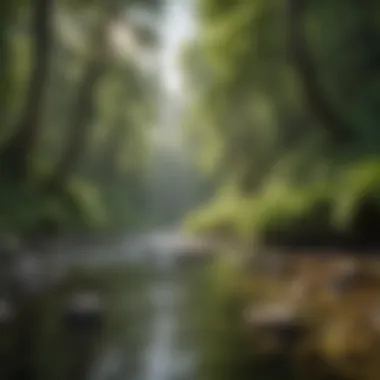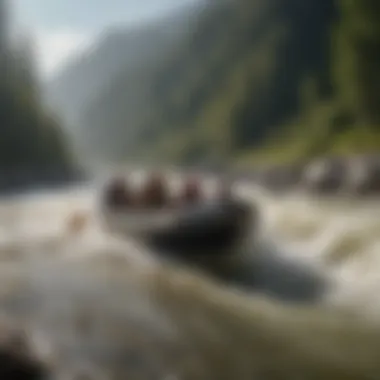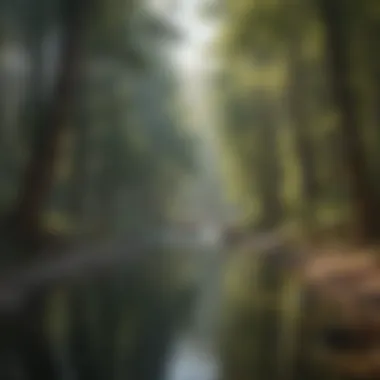Sauk River Rafting: An In-Depth Exploration of Nature


Intro
Sauk River rafting offers more than just an adventure; it represents a vital link between nature and human activity. As enthusiasts navigate the winding waters, they encounter varied terrains while appreciating the landscape's beauty. This comprehensive exploration will illuminate the significance of this outdoor activity, its interaction with ecosystems, and the community's relationship with the river. We will also address sustainable practices that ensure the river's health for future generations.
Understanding Woodland Ecosystems
Importance of Biodiversity in Forests
Forests surrounding the Sauk River are crucial for biodiversity. Various species, from trees to wildlife, coexist, forming a complex web of life. Each organism plays a role in maintaining ecological balance. For instance, native plants provide habitat and food for local animals, while insects contribute to pollination. The preservation of these ecosystems is not just an environmental concern; it directly influences the quality of the rafting experience. Healthy forests result in cleaner water and more vibrant wildlife, enhancing the area's appeal for outdoor activities.
Role of Forests in Climate Regulation
The forests along the Sauk River also play an essential part in climate regulation. They act as carbon sinks, absorbing CO2 from the atmosphere. This function mitigates some effects of climate change, underscoring the importance of maintaining these woodland areas. Furthermore, trees help regulate local climate conditions, influencing rainfall patterns and temperature stability, which can impact both ecosystems and recreational practices.
Sustainable Practices in Rafting
Encouraging Responsible Recreation
As river enthusiasts navigate the waters of the Sauk, it is necessary to adopt sustainable practices. This involvement involves respecting local regulations and minimizing impact on the environment. Educating visitors on the importance of not disturbing wildlife, avoiding littering, and practicing Leave No Trace principles can enhance the outdoor experience while preserving the area's natural beauty.
Community Involvement
Local communities play a significant role in ensuring the sustainability of the Sauk River. Engaging residents in conservation efforts helps foster a sense of ownership. Collaboration with conservation organizations further supports initiatives aimed at protecting the riverine ecosystem. Effective communication between stakeholders can lead to impactful changes that benefit both recreation and the environment.
"Sustainable practices are not merely beneficial to nature; they enrich the human experience in the outdoors."
Socio-Economic Implications of Sauk River Rafting
Economic Benefits of Outdoor Recreation
The Sauk River rafting activities generate economic advantages for local communities. Businesses that offer rafting gear rental, guided tours, and accommodations thrive due to the influx of visitors. This tourism contributes to job creation and supports a range of local services, such as restaurants and fuel stations, boosting the regional economy.
Preservation of Local Culture
Furthermore, rafting along the Sauk River fosters strong community ties and helps preserve local culture. Traditions surrounding outdoor activities encourage intergenerational relationships, as families and groups come together to enjoy nature. This connection to the land enriches community life and reinforces a shared identity rooted in stewardship of the environment.
Epilogue
Sauk River rafting encompasses more than just an adventure; it is intertwined with ecological significance and community resilience. By understanding the delicate balance of woodland ecosystems, advocating for sustainable practices, and recognizing the socio-economic implications, we can facilitate meaningful engagement with this natural resource. Engaging in responsible recreation and fostering local partnerships ultimately benefits both the river and those who cherish it.
Prelude to Sauk River Rafting
Sauk River rafting represents a blend of thrill and appreciation for nature's design. It provides not just recreational enjoyment but also incorportates deeper connections to the environment and local culture. Understanding this multidimensional aspect is vital for both enthusiasts and scholars in the field of outdoor activities.
Geographical Overview
The Sauk River flows through a picturesque part of Washington state. It begins near the foot of the North Cascade Range, stretching over 30 miles to its confluence with the Skagit River. The river's path crosses diverse landscapes, covering dense forests, open fields, and rocky terrains. The geographical diversity plays a significant role in the river's rapids and their classifications, which are influenced by the area's elevation changes and geological features.
The river’s flow varies significantly between seasons, highlighting the importance of local rainfall and snowmelt. Typically, spring sees a surge in water flow, creating class III to IV rapids that attract experienced rafters. The character of the river shifts during summer and fall, leading to calmer waters suitable even for beginners. This geographical versatility showcases the varied experiences that the Sauk River offers to different types of rafters.
Historical Context
The history of the Sauk River is rich and varied, steeped in the traditions of the native peoples who have lived in the region for thousands of years. Indigenous tribes historically relied on the river for sustenance, utilizing its resources for fishing, trade, and cultural ceremonies. As settlers arrived in the 19th century, the river was increasingly recognized for its recreational potential.
Today, the Sauk River holds significance for both recreation and environmental preservation. The establishment of nearby parks and protected areas reflects efforts to balance human activities with ecological conservation. The river remains a site not only of adventure but also of education regarding historical land use and ecological stewardship. Awareness of this historical context enhances the experience for rafters, connecting them to the land's narrative, which is essential for informed and responsible interaction with nature.


"Understanding the inherent value of locales like the Sauk River is key to fostering respect and responsibility among outdoor enthusiasts."
This comprehensive knowledge of the geographical and historical intricacies of Sauk River rafting contributes to a more profound engagement with the area, fostering a sense of stewardship among those who enjoy its waters.
Ecological Significance of the Sauk River
The Sauk River is not just a recreational hub; it plays a critical role in maintaining the ecological balance within its watershed. Understanding its ecological significance reveals how interlinked it is with the biodiversity and health of surrounding environments. This section delves into the local flora and fauna that thrive in and around the river, as well as the river's water quality that provides a foundation for these ecosystems.
Local Flora and Fauna
The lush ecosystems of the Sauk River are home to various plants and animals. This biodiversity is essential for sustaining a healthy environment. Trees like the hardwoods are prominent along the banks, offering shade and habitat. Willows, cottonwoods, and various shrubs line the river, creating a sheltering environment for many species.
In terms of wildlife, the river hosts numerous fish species, such as salmon and trout, which rely on clean, flowing water to thrive. These fish not only support local fishing communities but also play a role in the food web, feeding birds and mammals. Birds such as ospreys and herons are common sights. Their presence indicates a healthy ecosystem, as they rely on abundant fish populations.
Furthermore, the river supports a range of mammals, including otters and beavers. These animals contribute to the river's ecological health by managing its vegetation and waterways.
"The diversity of species supported by the Sauk River illustrates its importance for regional biodiversity and ecosystem services."
In addition, the wetlands that form in this area provide habitat for numerous amphibians, reptiles, and invertebrates. The interaction between these species sustains the food chain and maintains the overall ecological health of the region.
Water Quality Assessment
The quality of water in the Sauk River is crucial for the health of its ecosystems. Regular assessments show that water quality can be influenced by various factors like agricultural run-off, urban development, and natural sedimentation. These elements are monitored to ensure that aquatic life flourishes.
Key indicators of water quality include:
- Dissolved oxygen levels: Essential for aquatic life; lower levels can stress fish populations.
- Nutrient levels: Excessive nitrogen and phosphorus can lead to algal blooms, which may harm water quality.
- pH levels: Ideally, water should be slightly acidic to neutral for healthy ecosystems.
- Contaminant levels: Monitoring for pollutants such as heavy metals is essential for guarding against environmental degradation.
Regular sampling and assessment help local organizations and conservation groups to implement strategies that mitigate pollution and improve the river's overall health. Protecting water quality ensures not only the survival of the flora and fauna but also sustains recreational activities like rafting and fishing, which draw people to the Sauk River.
This holistic view of the river's ecology emphasizes the need for ongoing conservation efforts and responsible management practices.
Rafting Dynamics and River Classifications
Rafting dynamics and river classifications consider many factors. These points shape the experience for enthusiasts and determine the safety of rafting on the Sauk River. Understanding these elements is critical for both prospective rafters and conservationists. Knowledge of how river classes work can influence trip planning and equipment choices.
Understanding River Classifications
River classifications categorize waterways based on their features and has four main classes. Each class indicates the level of difficulty and hazards present. Here are the main classes:
- Class I: Easy, with minimal obstacles and small waves. Suitable for beginners.
- Class II: Some challenging sections, with small rapids and manageable obstacles.
- Class III: More significant rapids and larger waves, requiring experience and skill.
- Class IV: Difficult rapids with powerful currents and hazards that demand expert handling.
The Sauk River features rapids classified from Class I to Class III, making it accessible to a broader range of skills while also providing excitement for more experienced rafters. This classification plays a crucial role when deciding which parts of the river to navigate based on personal skill levels and the type of experience desired.
"Each classification serves as a guideline to help ensure safety and enjoyment on the water, making it essential for rafters to respect the classifications."
Specific Rapids on the Sauk River
The Sauk River hosts various rapids, each with unique characteristics. Knowing the locations and intensity of these rapids is important for planning a successful rafting trip. Some notable rapids include:
- The Monster: A Class III rapid known for its high waves and turbulence. Orientation is key to navigate successfully.
- The Chute: Another Class II rapid which is bumpy in spots but manageable for novice rafters.
- The S-turns: A series of Class II rapids that add a level of complexity, demanding quick decision-making from participants.
Each of these rapids presents unique challenges and exciting experiences, allowing rafters to test their skills and enjoy the beauty of the river. The variety of these features enhances the recreational appeal of the Sauk River while promoting responsible engagement with the environment.
Equipment and Preparation for Rafting
Preparing for a rafting trip on the Sauk River is not just about enthusiasm; it requires adequate planning and the right gear. Proper equipment enhances safety, maximizes enjoyment, and fosters a responsible approach to outdoor recreation. Understanding the significance of this preparation can make the difference between a memorable experience and potential hazards.


When embarking on such an adventure, one must consider the gear that ensures safety, comfort, and efficiency. Additionally, it serves a dual purpose by preserving the pristine nature of the river and its surroundings. A well-prepared rafter is more likely to respond effectively to unexpected situations, contributing to an overall safer rafting environment.
Essential Gear List
Here are some essential items to consider:
- Raft: Choose a suitable raft designed for whitewater. Options include inflatables or hard-shell types.
- Paddles: High-quality paddles to provide control and maneuverability.
- Personal Flotation Device (PFD): A must-have for safety, ensuring all participants wear one.
- Helmet: To protect against potential impacts with rocks or other objects.
- Wet Suit/Dry Suit: Depending on the temperature, to retain body heat during colder excursions.
- First Aid Kit: Crucial for treating minor injuries and ensuring readiness for emergencies.
- Dry Bags: To keep personal items and gear safe from water exposure.
- Footwear: Water shoes or sandals with straps for protection and stability.
An organized gear setup enhances efficiency, allowing rafters to focus on the river's dynamics rather than dealing with misplaced items.
Safety Protocols and Guidelines
Ensuring safety during rafting requires adherence to established protocols. Proper preparation also includes understanding and implementing these guidelines.
- Pre-trip Briefing: Discuss safety measures with all participants before hitting the water.
- Escape Routes: Know your surroundings and identify safe spots for exit if necessary.
- Group Coordination: Establish roles within the group for communication and teamwork.
- Monitor Weather Conditions: Being aware of the forecast can help avoid dangerous situations.
- Use of Safety Equipment: Reinforce the necessity of PFDs, helmets, and other gear while on the river.
"Safety is not just a personal concern; it is a shared responsibility among all rafters."
Accidents can happen, but preparation and knowledge significantly reduce risks. Awareness of environmental conditions, respect for nature, and proper equipment usage are essential in safeguarding both the rafters and the river ecosystem. Engaging deeply with these aspects cultivates a culture of safety and respect in the communal enjoyment of the Sauk River.
Local Regulations and Conservation Efforts
The presence of robust regulations and conservation efforts is crucial to maintain the ecological balance and sustainability of the Sauk River area. As an outdoor recreational activity, rafting has seen increased popularity, which brings forth the need for careful management. These regulations are designed not only to protect the natural habitat but also to ensure the safety and enjoyment of all visitors.
Permitting and Legal Considerations
Engaging in rafting on the Sauk River may require specific permits, depending on the time of year and the type of activity planned. Authorities typically manage these permits to regulate the number of participants and minimize environmental impact. These legal considerations often encompass guidelines regarding:
- Group Size: Limits on the number of individuals per raft to ensure safety and reduce overcrowding.
- Timing: Seasonal rules may apply to safeguard local wildlife during breeding periods.
- Environmental Impact: Regulations aimed at preserving the delicate ecosystem of the river and its surroundings.
Obtaining necessary permits is not just a formality; it is a commitment to responsible outdoor ethics. Failure to adhere to the permitting process can result in fines or a ban from accessing the river. Understanding these legal requirements is vital for everyone involved in rafting activities.
Community Conservation Initiatives
Local communities play a significant role in the conservation of the Sauk River. Various grassroots initiatives have emerged to actively engage residents and visitors in protecting this valuable resource. Some notable efforts include:
- Cleanup Drives: Organized events where volunteers gather to remove debris and litter from the river and its banks.
- Educational Programs: Workshops aimed at teaching about the local ecology and importance of preservation efforts.
- Partnerships with Local Governments: Collaborations to develop sustainable practices that involve community input and expertise.
These initiatives not only foster a spirit of stewardship among those who use the river but also enhance overall community bonding by encouraging shared responsibility.
"Preserving the Sauk River is not just about the environment; it’s also about ensuring that future generations can enjoy its beauty and recreational opportunities."
Impact of Rafting on Local Communities
Rafting on the Sauk River significantly affects the local communities, transforming both social structures and economic conditions. This section aims to outline the various dimensions of this impact. Understanding these elements is crucial for appreciating the broader implications of outdoor activities like rafting, especially in relation to sustainability and community needs.
Economic Benefits of Rafting Tourism
Rafting tourism brings notable economic advantages to local communities. Several studies show that regions with active rafting industries experience boost in local incomes, job creation, and increased commerce. Tourists spend on various services, including accommodations, food, and recreational rentals, leading to a trickle-down effect that supports local businesses. Over the years, many small shops, restaurants, and outfitters have emerged, catering specifically to rafters.
Moreover, rafting tourism often incentivizes infrastructure improvements. Roads, parks, and public facilities may receive much-needed attention and funding. With improved amenities, not only do tourists enjoy better experiences, but local residents also benefit from enhanced community resources.
The Sauk River serves as an ideal destination for both novice and expert rafters, drawing visitors from nearby areas and beyond. The influx of visitors encourages investments in safety training for local guides, increasing the skill level in the community while fostering a sense of pride among residents.
Community Engagement and Local Culture


Rafting fosters a deep connection between communities and nature. Engaging in such outdoor activities promotes a collective identity among residents, strengthening relational bonds within the community. Many local organizations conduct educational programs and events geared toward sharing the heritage associated with visiting the Sauk River.
The river can be a backdrop for community events that celebrate local traditions, such as festivals or clean-ups. These events not only entice more visitors but create a sense of ownership among local citizens. Volunteer participation may rise when people see how their actions directly influence the health of the river and the community’s culture.
Additionally, local culture is enhanced. People from different backgrounds unite to experience the river, opening doors for cultural exchange. The Sauk River rafting experience becomes more substantial as the community weaves its history and traditions into the tourism framework, promoting conservation and cultural appreciation.
"Community involvement is not just beneficial for economic health but an essential component for preserving cultural heritage tied to local natural resources."
In summary, the impact of rafting on local communities extends beyond economic gains. It cultivates a culture of engagement, reinforcing connections and promoting sustainable practices while enhancing local identities. Every paddle stroke in the water echoes the vibrant stories of community and conservation.
Challenges Facing the Sauk River
The Sauk River, like many natural water bodies, faces various challenges that threaten its ecological balance and the experience of those who raft upon its waters. Understanding these challenges is crucial. They not only affect the river’s health but also influence the sustainability of rafting activities and the broader community reliant on this resource. Addressing these issues is imperative to ensure both the preservation of the river's ecosystem and the enjoyment of its recreational offerings.
Environmental Threats and Solutions
The health of the Sauk River is compromised by several environmental threats, including pollution, habitat destruction, and climate change. These factors can significantly alter water quality and river conditions, which impacts both wildlife and human activities.
- Pollution: Industrial runoff and agricultural practices contribute to chemical pollutants entering the river. Excess nutrients from fertilizers can lead to algal blooms, which deplete oxygen levels in the water and harm aquatic life.
- Habitat Destruction: Activities such as logging and urban development can lead to loss of riparian zones, which serve as critical habitats for many species. Deforestation near the riverbanks also increases sedimentation, further degrading water quality.
- Climate Change: Variations in climate patterns can drastically change water flow rates, temperature, and seasonal patterns of wildlife. Higher temperatures may reduce water levels and increase evaporation rates.
- Solution: Implementing stricter regulations on runoff and promoting organic farming could reduce the amount of harmful substances entering the river. Community education on pollution's impact can also drive local engagement in conservation efforts.
- Solution: Restoration projects that focus on rebuilding riparian buffers are essential. This can involve replanting native vegetation and creating conservation easements to protect these vital habitats.
- Solution: Long-term strategies to combat climate change effects include promoting sustainable land management practices and investing in water conservation technologies.
The combination of community action and legislative support will play a pivotal role in addressing these environmental threats. Through education and awareness, it is possible to inspire change at both individual and community levels.
Sustainable Practices in Rafting
Sustainable practices are crucial in mitigating the impact of rafting on the Sauk River. As the popularity of rafting increases, so does the potential for environmental degradation. Adopting sustainable practices not only ensures the long-term viability of rafting but also preserves the river’s health.
- Leave No Trace Principles: Educating rafters about the importance of minimizing their impact is essential. This includes packing out all waste, avoiding disturbance to wildlife, and respecting fragile ecosystems.
- Utilizing Eco-Friendly Equipment: Encouraging the use of equipment made from sustainable materials can reduce the ecological footprint. Companies that provide rafting gear should be committed to sustainable production practices.
- Wildlife Awareness: Rafting can disrupt local wildlife. Educating rafters about local species and their habitats can foster respect for these integral parts of the ecosystem.
- By following these principles, visitors can help maintain the pristine nature of the river and surrounding habitats.
- Examples: Brands like NRS offer environmentally friendly options for rafters. Choosing these products can influence local manufacturers to adopt greener practices.
- Promoting wildlife observation rather than interference will help to balance recreational use with conservation needs.
"Sustainability in rafting is not just an option, but an obligation to future generations who will also seek to enjoy the Sauk River's beauty."
By integrating sustainable practices into rafting culture, the community can ensure that future generations continue to enjoy the natural beauty and recreational opportunities that the Sauk River offers. Encouraging collaboration among local stakeholders, government, and the rafting community can enhance these efforts, creating a unified approach to the challenges faced by the river.
Closure and Future Directions
Understanding the intricacies of Sauk River rafting allows us to appreciate its multifaceted impact on both nature and community. As we analyze the data and trends, it becomes evident that the continued enjoyment of the river requires a commitment to sustainable practices. This conclusion should not serve merely as a summary, but as a call to action for those involved in rafting, conservation, and community engagement. The various elements discussed throughout this article — from ecological considerations to community benefits — emphasize the need for a forward-thinking approach to river stewardship.
The Role of Education in Rafting Conservation
Education plays a pivotal role in fostering a culture of conservation among rafting enthusiasts. Programs tailored to increase awareness regarding the ecological implications of recreation are essential. These initiatives can take several forms, including workshops, guided river tours, and online resources. Through educational efforts, paddlers can gain deeper insights into the local ecosystem, learning about sensitive species and habitats along the river’s edge.
Such understanding can lead to a more responsible interaction with nature. It is crucial for rafters to realize their potential impact on the river environment, from minimizing waste to avoiding disturbances to wildlife. Ultimately, education empowers individuals to become proactive stewards of the environment, ensuring the river's health for future generations.
Visions for Sustainable Rafting Experiences
The concept of sustainable rafting experiences encapsulates several layers of responsibility. It goes beyond mere enjoyment; it requires an understanding of how actions can either contribute to or detract from the river's ecological balance. Future visions should prioritize the integration of environmentally friendly practices in the rafting sector. This includes opting for eco-sensitive rafting gear, collaborating with local conservation groups, and even engaging in river clean-up events.
To realize these visions:
- Engage with local communities to develop programs that encourage environmentally responsible tourism.
- Promote research that investigates the effectiveness of current conservation efforts and recommends improvements.
- Leverage technology to educate and inform participants before they set out on their adventures, ensuring a more respectful encounter with nature.
To secure the future of Sauk River rafting, we must align our collective efforts towards sustainable practices that nurture both human enjoyment and ecological integrity.







